Stef Bundle
Can STEF S.A. Maintain Its Cold Chain Dominance?
STEF S.A., a European leader in temperature-controlled logistics, has strategically expanded its footprint, most notably with the 2023 acquisition of Langdon in the UK. This move underscores STEF's commitment to aggressive growth and market leadership in the specialized food logistics sector. Founded in 1920, STEF's journey from a French enterprise to a European powerhouse demonstrates remarkable adaptability and expansion capabilities.
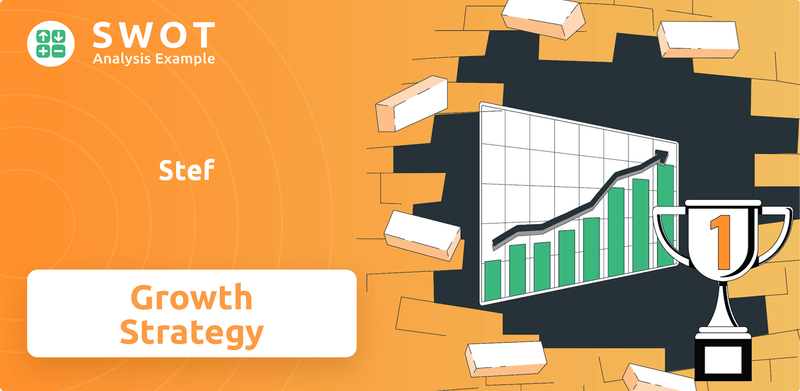
This exploration delves into the Stef SWOT Analysis, providing a comprehensive look at the company's Stef Company Growth Strategy and Stef Company Future Prospects. We'll examine Stef Company's Business Model, analyze its Market Position, and assess its Financial Performance to understand how STEF plans to navigate the evolving logistics landscape. Furthermore, we will address questions such as: What are the current growth strategies of Stef Company; How does Stef Company approach market expansion; and What is Stef Company's vision for the next five years?
How Is Stef Expanding Its Reach?
The expansion initiatives of the company are primarily focused on fortifying its European network, penetrating new geographical markets, and enhancing its service offerings to meet the evolving demands of the food industry. This strategic approach aims to capitalize on growth opportunities and solidify its market position. Understanding the Stef Company Growth Strategy is crucial for assessing its future prospects.
A key element of this strategy involves strategic acquisitions and organic growth. These initiatives are designed to increase capacity, improve efficiency, and expand its service portfolio. The company's approach to market expansion is multifaceted, combining acquisitions with investments in infrastructure and service development. This dual strategy supports both short-term gains and long-term sustainability.
The company's expansion strategy is also driven by the need to adapt to changing market trends and customer demands. By focusing on urban logistics and specialized services, the company aims to meet the increasing need for last-mile delivery of fresh and frozen products. These moves are critical for the Stef Company Future Prospects.
The acquisition of Langdon in the UK in 2023 was a significant step in strengthening its presence in the British market. This strategic move provided a substantial foothold and enhanced cross-border capabilities. The acquisition was driven by the desire to access new customer bases and diversify revenue streams within a strategically important region.
The company is actively pursuing organic growth by expanding its logistics infrastructure. This includes investments in new warehouses and logistics platforms, such as the new cold storage facility in the Netherlands, which became operational in early 2024. These expansions are designed to increase capacity and improve efficiency in key distribution hubs.
The company focuses on developing specialized services, including urban logistics solutions, to meet the increasing need for last-mile delivery of fresh and frozen products. This focus aligns with changing market demands and supports the company's growth strategy. The development of specialized services is a key component of its strategic plan.
The company aims to achieve further growth through strategic partnerships and collaborations. These collaborations enhance its service portfolio and reach within the food sector. Strategic alliances are a key element in expanding its market presence and improving its competitive position.
The company's expansion strategy encompasses acquisitions, organic growth through infrastructure investments, and the development of specialized services. These initiatives support its long-term financial goals and enhance its market position. A comprehensive Stef Company Analysis reveals the effectiveness of these strategies.
- Acquisitions to enter new markets and expand its network.
- Investments in new warehouses and logistics platforms to increase capacity.
- Development of specialized services, such as urban logistics, to meet evolving customer needs.
- Strategic partnerships and collaborations to enhance its service portfolio and reach.
Stef SWOT Analysis
- Complete SWOT Breakdown
- Fully Customizable
- Editable in Excel & Word
- Professional Formatting
- Investor-Ready Format
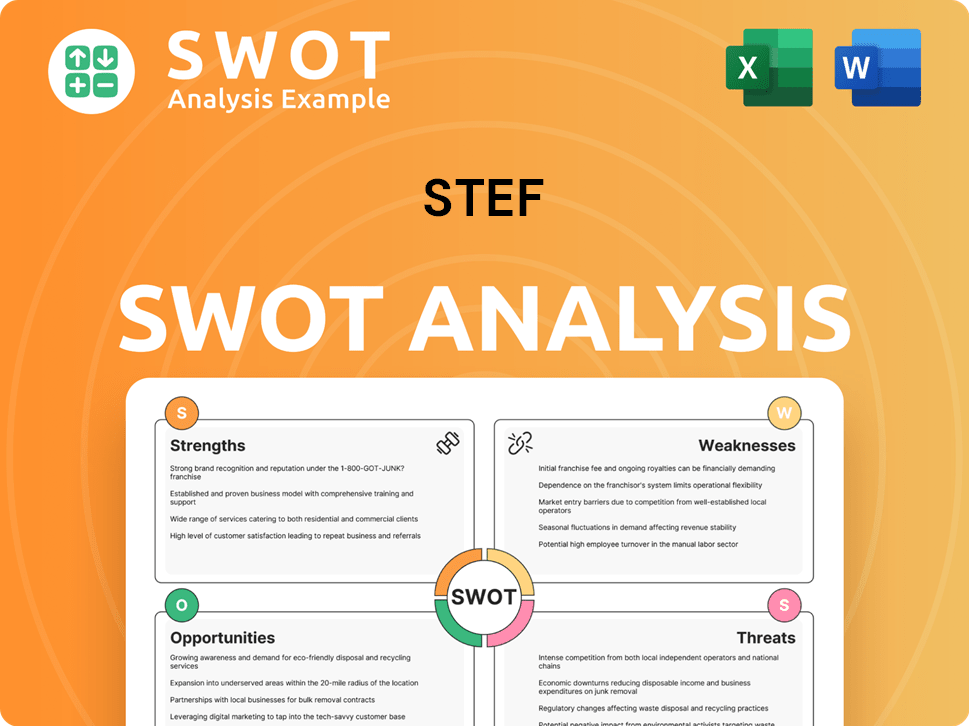
How Does Stef Invest in Innovation?
The company prioritizes innovation and technology to maintain its leadership in temperature-controlled logistics. This focus includes digital transformation, automation, and sustainable solutions, which are crucial for long-term growth. The company invests heavily in research and development to optimize its cold chain operations, ensuring the integrity and safety of goods.
A core element of the company's strategy involves integrating advanced warehouse management systems (WMS) and transport management systems (TMS). These systems are designed to enhance operational efficiency, reduce energy consumption, and provide real-time tracking of perishable goods. These technological advancements are critical for meeting the evolving demands of the logistics industry.
The company is also exploring cutting-edge technologies like artificial intelligence (AI) for demand forecasting and route optimization. Furthermore, the Internet of Things (IoT) is being utilized to enhance temperature monitoring in its facilities and vehicles. These initiatives highlight the company's commitment to leveraging technology for improved performance and sustainability, ultimately supporting its growth objectives and Owners & Shareholders of Stef.
The company's technological advancements not only contribute to operational excellence but also support its growth objectives by providing more efficient, reliable, and sustainable logistics solutions. The company's commitment to sustainability is evident through its investment in a greener fleet, including electric and natural gas-powered vehicles. The company is targeting a significant reduction in its carbon footprint by 2030, aligning with broader industry trends toward environmentally responsible logistics.
- AI and Machine Learning: Implementation of AI for demand forecasting, route optimization, and predictive maintenance. According to a 2024 report, AI-driven solutions can improve route efficiency by up to 15%.
- IoT Integration: Deploying IoT sensors for real-time temperature monitoring in warehouses and transport vehicles. Data from these sensors enables proactive management and reduces spoilage.
- Warehouse Automation: Investing in automated storage and retrieval systems (AS/RS) and robotic solutions to enhance efficiency and reduce labor costs. Automation can increase warehouse throughput by up to 20%.
- Sustainable Fleet: Transitioning to electric and natural gas-powered vehicles to reduce emissions. The company aims to have a significant portion of its fleet powered by alternative fuels by 2030.
Stef PESTLE Analysis
- Covers All 6 PESTLE Categories
- No Research Needed – Save Hours of Work
- Built by Experts, Trusted by Consultants
- Instant Download, Ready to Use
- 100% Editable, Fully Customizable
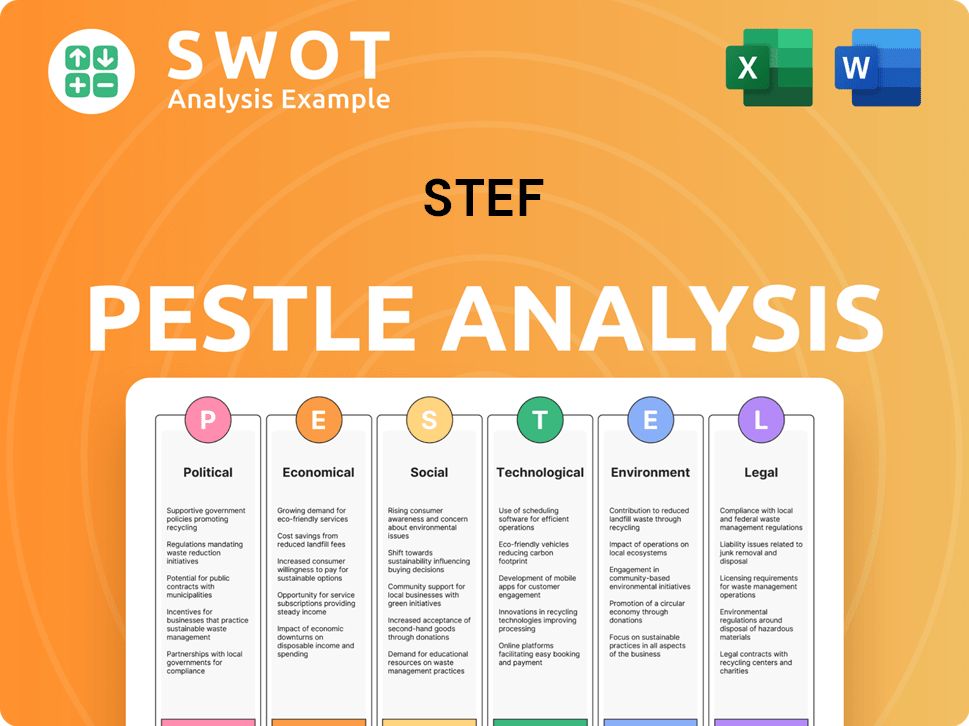
What Is Stef’s Growth Forecast?
The financial outlook for the company appears strong, supported by its strategic initiatives and operational efficiencies. In 2023, the company saw a significant increase in revenue, reaching €4.8 billion, which represents a 6.7% increase compared to 2022. This growth is a result of both organic expansion and strategic acquisitions, such as the integration of Langdon. The company aims to maintain this positive trend, targeting sustained revenue growth in 2024 and beyond. The financial strategy emphasizes maintaining healthy profit margins and investing in infrastructure and technology to support long-term growth. This Target Market of Stef analysis helps to understand the company's position.
The company's financial reports indicate a robust balance sheet, providing a solid base for future investments and potential acquisitions. Analyst forecasts generally align with the company's optimistic outlook, highlighting its stable market position and the essential nature of its services within the food industry. The company also focuses on optimizing operational costs and enhancing productivity to further improve profitability. This financial narrative supports the company's strategic plans, demonstrating its capacity to fund ambitious expansion projects and technological advancements while delivering value to its shareholders.
The company's financial performance is a key indicator of its overall health and future prospects. The company's ability to maintain and improve its financial results is crucial for its long-term success. Understanding the financial aspects is essential for assessing the company's potential. The company's financial performance is closely tied to its growth strategy.
The company reported a consolidated revenue of €4.8 billion in 2023, marking a 6.7% increase from the previous year. This growth reflects the success of the company's business model and its ability to capture market opportunities. The increase in revenue is a positive sign for the company's future prospects.
The company focuses on maintaining healthy profit margins through operational efficiencies and strategic cost management. Enhancing profitability is a key objective, enabling the company to reinvest in growth initiatives and strengthen its financial position. The company's profitability is a crucial factor in its long-term sustainability.
The company is committed to investing in infrastructure, technology, and strategic acquisitions to support long-term growth. These investments are designed to enhance operational capabilities, expand market reach, and improve service offerings. Strategic investments are critical for the company's future prospects.
The company's strong balance sheet provides a solid foundation for future investments and potential acquisitions. Financial stability is essential for navigating market fluctuations and pursuing growth opportunities. The company's financial stability supports its long-term goals.
The company's long-term financial goals include sustained revenue growth, improved profitability, and strategic investments. These goals are supported by a robust business model and a focus on operational excellence. The company's financial performance is driven by these key objectives.
- Sustained Revenue Growth: Targeting consistent revenue increases through market expansion and service enhancements.
- Improved Profitability: Enhancing profit margins through cost optimization and operational efficiencies.
- Strategic Investments: Allocating resources to infrastructure, technology, and acquisitions to support long-term growth.
- Financial Stability: Maintaining a strong balance sheet to support future investments and acquisitions.
Stef Business Model Canvas
- Complete 9-Block Business Model Canvas
- Effortlessly Communicate Your Business Strategy
- Investor-Ready BMC Format
- 100% Editable and Customizable
- Clear and Structured Layout
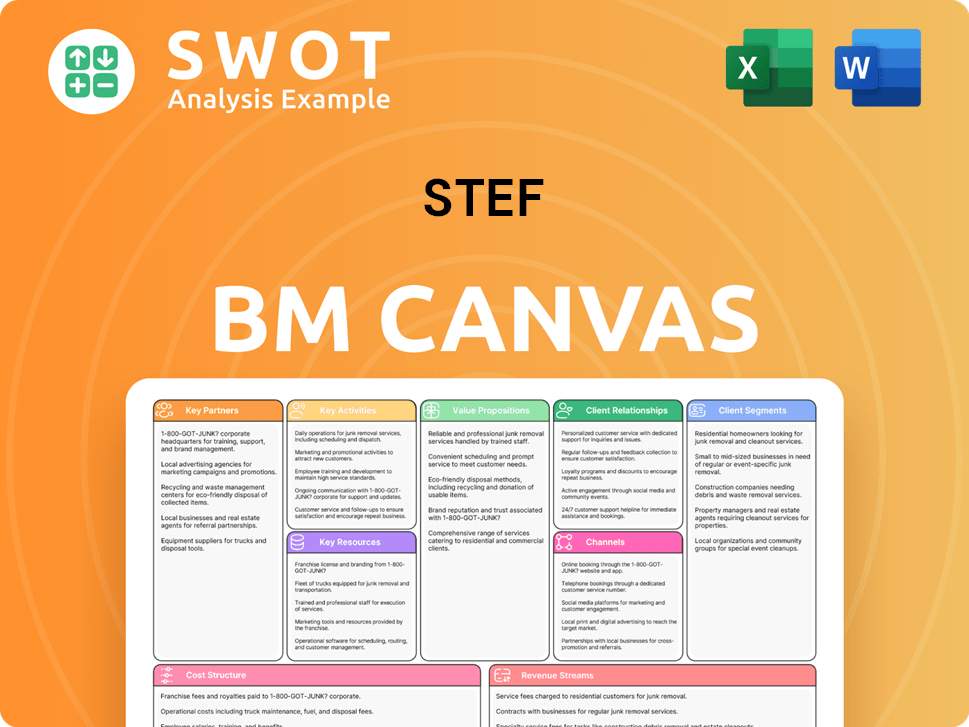
What Risks Could Slow Stef’s Growth?
The Stef Company Analysis reveals several potential risks and obstacles that could influence its future. Despite its strong market position and growth ambitions, various challenges could impact its trajectory. Understanding these risks is crucial for assessing the long-term viability of the company and its strategic planning.
Market competition, regulatory changes, and supply chain vulnerabilities are key areas of concern. Additionally, technological disruptions and internal resource constraints present significant hurdles. The ability of the company to navigate these challenges will be critical to its sustained success and achieving its long-term financial goals, as outlined in the Revenue Streams & Business Model of Stef article.
The company's response to past challenges, such as Brexit and the COVID-19 pandemic, demonstrates resilience. However, ongoing vigilance and proactive strategies are necessary to mitigate the impact of these risks effectively. Addressing these challenges is vital for maintaining its competitive edge and capitalizing on future opportunities in the logistics industry.
The temperature-controlled logistics sector is highly competitive. Numerous players vie for market share, putting pressure on pricing and margins. This competition necessitates continuous innovation and efficiency improvements to maintain a strong market position.
Changes in environmental standards and food safety regulations across Europe can increase operational costs. Compliance with these regulations requires significant investment and adaptation, potentially affecting profitability. Staying compliant with evolving regulations is crucial.
Disruptions due to geopolitical events, climate change, or pandemics can impact the flow of goods. These disruptions can lead to increased costs and operational complexities. Diversifying supply chains and building resilience are key.
Rapid advancements in automation, AI, and sustainable logistics solutions can disrupt the industry. Failing to keep pace with these advancements could lead to a loss of competitiveness. Investing in technology is essential.
Limited availability of skilled labor and capital for large-scale investments can impede growth. Attracting and retaining skilled workers and securing sufficient funding are crucial for expansion. Managing resources effectively is critical.
Political instability or trade disputes in key regions can disrupt operations and supply chains. Monitoring and adapting to geopolitical risks is essential for business continuity. Diversification and risk mitigation strategies are important.
The company mitigates risks through diversification of its client base and geographical presence. Robust risk management frameworks and continuous investment in technology and talent development are also key. These strategies help build resilience.
The company has shown resilience in overcoming past challenges. Adapting to Brexit and the operational demands of the COVID-19 pandemic demonstrates its ability to address emerging risks effectively. Learning from past experiences is valuable.
Stef Porter's Five Forces Analysis
- Covers All 5 Competitive Forces in Detail
- Structured for Consultants, Students, and Founders
- 100% Editable in Microsoft Word & Excel
- Instant Digital Download – Use Immediately
- Compatible with Mac & PC – Fully Unlocked
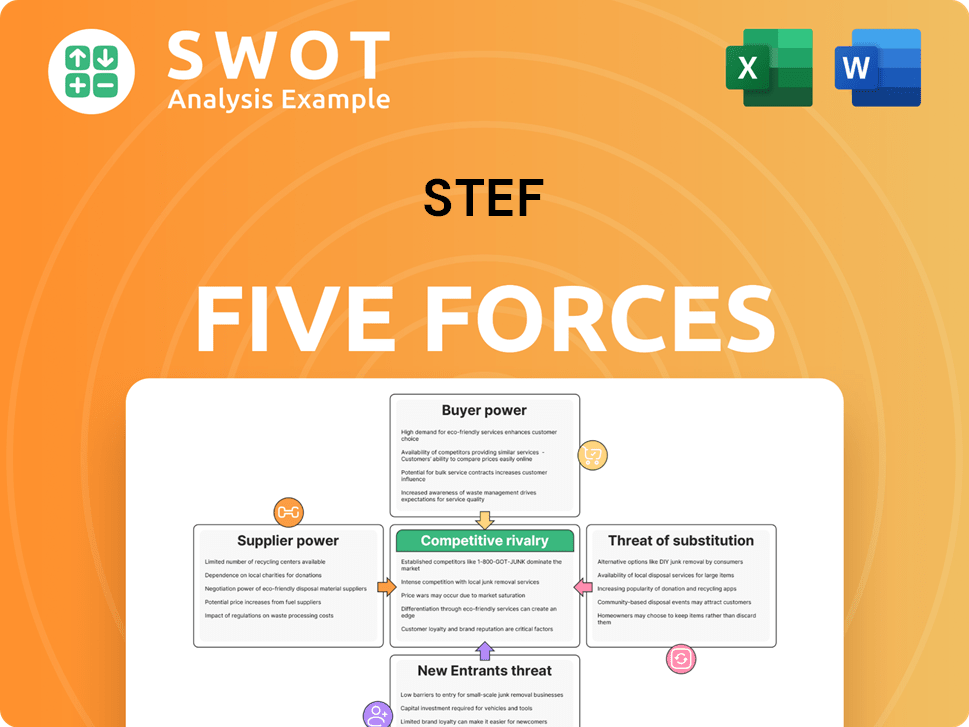
Related Blogs
- What are Mission Vision & Core Values of Stef Company?
- What is Competitive Landscape of Stef Company?
- How Does Stef Company Work?
- What is Sales and Marketing Strategy of Stef Company?
- What is Brief History of Stef Company?
- Who Owns Stef Company?
- What is Customer Demographics and Target Market of Stef Company?
Disclaimer
All information, articles, and product details provided on this website are for general informational and educational purposes only. We do not claim any ownership over, nor do we intend to infringe upon, any trademarks, copyrights, logos, brand names, or other intellectual property mentioned or depicted on this site. Such intellectual property remains the property of its respective owners, and any references here are made solely for identification or informational purposes, without implying any affiliation, endorsement, or partnership.
We make no representations or warranties, express or implied, regarding the accuracy, completeness, or suitability of any content or products presented. Nothing on this website should be construed as legal, tax, investment, financial, medical, or other professional advice. In addition, no part of this site—including articles or product references—constitutes a solicitation, recommendation, endorsement, advertisement, or offer to buy or sell any securities, franchises, or other financial instruments, particularly in jurisdictions where such activity would be unlawful.
All content is of a general nature and may not address the specific circumstances of any individual or entity. It is not a substitute for professional advice or services. Any actions you take based on the information provided here are strictly at your own risk. You accept full responsibility for any decisions or outcomes arising from your use of this website and agree to release us from any liability in connection with your use of, or reliance upon, the content or products found herein.